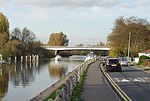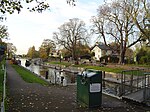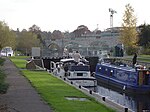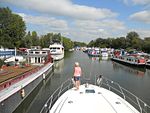Laleham

Laleham is a village on the River Thames, in the Borough of Spelthorne, about 17 mi (27 km) west of central London, England. Historically part of the county of Middlesex, it was transferred to Surrey in 1965. Laleham is downriver from Staines-upon-Thames and upriver from Chertsey. The north of the area has a number of sports fields, including the Staines and Laleham Sports Ground, and two family pubs, one each on the Laleham and Ashford Roads. Laleham Park, by the River Thames, is south of the village. Laleham is just over 3 miles (5 km) from three motorway junctions. The nearest railway station is Staines, 1.5 miles (2.4 km) north, on the Waterloo to Reading Line. Two Surrey County Council bus routes serve the village. The poet Matthew Arnold (1822–88) lived here, dividing his time between Laleham and Rugby School.
Excerpt from the Wikipedia article Laleham (License: CC BY-SA 3.0, Authors, Images).Laleham
Shepperton Road, Borough of Spelthorne
Geographical coordinates (GPS) Address Nearby Places Show on map
Geographical coordinates (GPS)
| Latitude | Longitude |
|---|---|
| N 51.407 ° | E -0.488 ° |
Address
Shepperton Road
Shepperton Road
TW18 1SD Borough of Spelthorne
England, United Kingdom
Open on Google Maps







